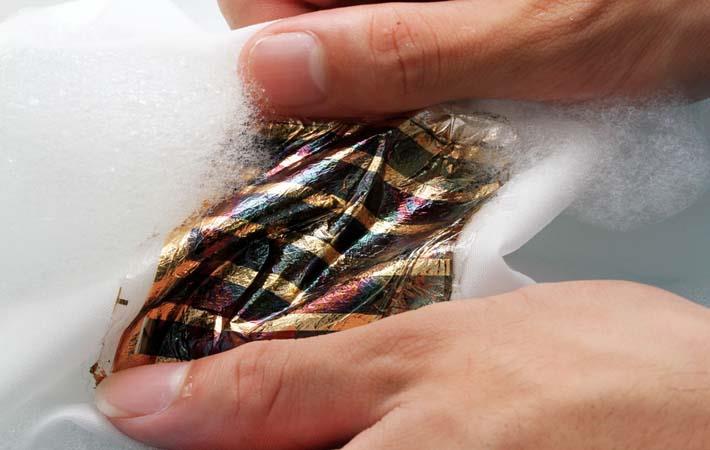Scientists at RIKEN have created washable organic solar cells. The ultrathin photovoltaic cells can be stretched by half their length and withstand 20 washing cycles which means these could be incorporated into textiles and Internet-of-Things devices to create electricity-generating clothing, power personal health monitors, and recharge mobile devices.
The research was led by Takao Someya .This is the first time that a single solar cell has combined a high energy efficiency, stretchability, and stability in air and water, explains lead researcher Kenjiro Fukuda from the Thin-Film Device Laboratory (Chief Scientist Laboratory) and the RIKEN Center for Emergent Matter Science (CEMS).Scientists at RIKEN have created washable organic solar cells. The ultrathin photovoltaic cells can be stretched by half their length and withstand 20 washing cycles which means these could be incorporated into textiles and Internet-of-Things devices to create electricity-generating clothing, power personal health monitors, and recharge mobile devices.#
The work began, he says, when Kazuo Takimiya’s group at CEMS developed the solar cell’s ultrathin organic active layer, an organic photovoltaic (OPV). The layer converts sunlight into electricity at an efficiency of nearly eight per cent, while also being very stable in air and water. Thicker OPVs can claim a peak conversion of 10 per cent—but for a photovoltaic material that is only one micrometer thick, eight per cent is very high. And since the active material is very thin and based on an organic material, it can flex without breaking.
But the first solar cells produced with this active layer were not stretchable and were easily scratched. Fukuda’s group solved these issues by placing stretched rubber-like elastomer films over the outside. “First, we pre-stretch the elastomer and fix the ultrathin solar cells gently,” says Fukuda. “Next, the second elastomer is pre-stretched and attached, and we achieve this kind of sandwich structure.” When the elastomer films were allowed to relax, the embedded solar cell folded itself into an accordion-like structure with troughs and peaks.
This folded structure gives the cell its stretchability—when it is pulled, the folds flatten out, meaning the device can be extended up to half its length without damage.
The elastomer films also somewhat waterproofed the cells making them washable— something that the researchers tested by subjecting the cells to 20 cycles of mechanical compression while exposing them to water for one hour and 40 minutes. The cell’s efficiency dropped by only 20 per cent after this process.
The hope is that these solar cells could power electronic devices such as sensors to measure a wearer’s heart rate, body temperature, blood pressure and other important medical parameters. They could also allow doctors to more easily monitor an out-patient’s condition as well as enable athletes to continually measure their performance. “Recently, smart sensors that monitor the heartbeat, pressure or electrodermal activity, have been attracting attention,” says Fukuda. “So there are now a lot of textiles with sensors embedded. By combining these technologies with our solar cells, we could achieve some very smart sensor clothes systems.”
In the future, if sufficiently high voltages and currents can be realised, solar cells in clothing could also be used to recharge mobile devices and may even be able to supply household electricity, meaning things like OPV awnings could be used in, for example, developing regions.
If the solar cells could be combined with thin, lightweight batteries, their usefulness could be enhanced even further. “We need a very thin or stretchable battery system, but this very difficult to realise,” says Fukuda. “Batteries need some thickness to store a lot of power.” But he adds: “If we can find a suitable collaborator, we could realise good synergy between our team and a battery research group.”
Currently, OPV models cannot compete against traditional inorganic solar cells for longevity and therefore price. Rooftop models target lifetimes of 20 years, while organic photovoltaic cells are targeting lifetimes of less than 10 years for glass-based products and less than five years for flexible products. German researchers Ning Li and Christoph J Brabec noted this in a commentary piece on RIKEN’s OPVs for Nature Energy.
Fukuda says that real-world practical applications are probably three to five years down the track, but already there has been interest from companies in commercialising the technology.
The two main hurdles that will need to be overcome are the cost and size of the solar cells. The cells are currently limited to 10 centimeters by 10 centimeters and are fairly expensive to fabricate. But this is mostly down to the cost of the active layer, says Fukuda. The film coating is actually very thin and will ultimately reduce costs. “If companies commercialise this technology, they could develop a way to mass-produce the active layer material and reduce the cost,” he says,
“Many companies are interested in our technology and have contacted us recently,” he says. Fukuda and his team are currently working on improving the cells’ stability in air and stretchability. (SV)
Fibre2Fashion News Desk – India
